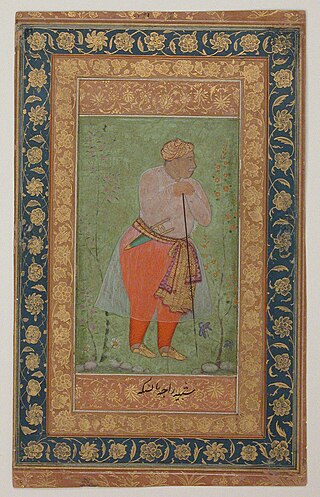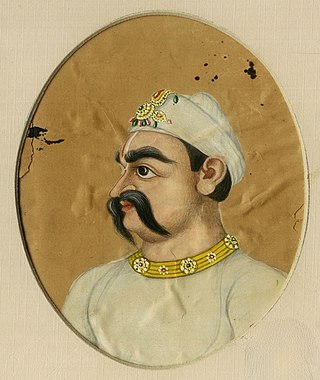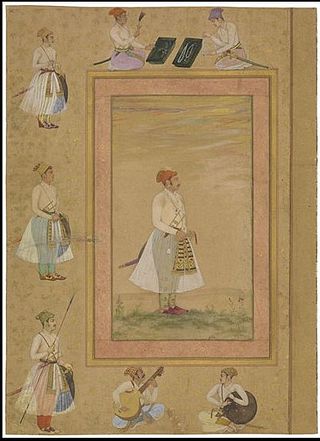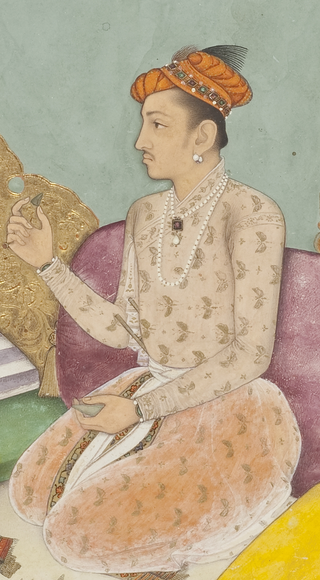
Sawai Jai Singh II, was the 29th Kachwaha Rajput ruler of the Kingdom of Amber, who later founded the fortified city of Jaipur and made it his capital. He became the ruler of Amber at the age of 11, after the untimely death of his father Mirza Raja Bishan Singh on 31 December 1699.

Maharaja Suraj Mal, simply known as Suraj Mal, was a Jat ruler of Bharatpur State in the present-day state of Rajasthan. Under him, Bharatpur State, a tributary of the House of Scindia, covered the present-day districts of Agra, Alwar, Aligarh, Bharatpur, Dholpur, Etawa, Hathras, Mainpuri, Meerut, Ghaziabad, Mathura, and Rohtak, Sonipat, Jhajjar, Nuh, Palwal, Faridabad, Kasganj, Mainpuri, Firozabad, Bulandshahr.

The Kachhwaha & Kushwah is a Rajput clan found primarily in India.

Ajit Singh Rathore was the ruler of Marwar region in the present-day Rajasthan and the son of Jaswant Singh Rathore. He also served as the Subahdar of Gujarat for two terms from 1715–1717 and 1719–1721.

Gokula was a Zamindar of Tilpat region who led the Hindu Zamindars to a revolt against Mughal rule, during the reign of the Mughal Emperor Aurangzeb.

RajaMan Singh I was the 24th Maharaja of Kingdom of Amber from 1589 to 1614. He also served as the Subahdar of Bihar from 1587 to 1594, then for Bengal for three terms from 1595 to 1606 and the Subahdar of Kabul from 1585 to 1586. He served in the Mughal Army under Emperor Akbar. Man Singh fought sixty-seven important battles in Kabul, Balkh, Bukhara, Bengal and Central and Southern India. He was well versed in the battle tactics of both the Rajputs as well as the Mughals. He is commonly considered to be one of the Navaratnas, or the nine (nava) gems (ratna) of the royal court of Akbar.
Raja Ram Sinsinwar was the first leader, who organised a rebellion against Aurangzeb. He was the chieftain of Sinsini. Before Rajaram the zamindars were organised by different village heads dotted around Agra, Mathura and the Yamuna river. To avenge the death of Gokula, Rajaram attacked Akbar's tomb and dragged Akbar's bones and burned them with the help of the Zamindars of Braj. After his death, his brother Churaman and son Fateh Singh continued the struggle against Aurangzeb.

Churaman was a chieftain of Sinsini, Rajasthan. He became leader of the zamindars after Rajaram's death. Bahadur Shah I made him a mansabdar after he supported him against Muhammad Azam Shah in becoming the emperor. He was also made the faujdar of Mathura, and the imperial highway from Delhi to Agra was placed under his protection by the Mughal Emperor.

Mirza Raja Ram Singh I was the Raja of the Kingdom of Amber and head of the Kachwaha Rajput clan, succeeding his father Mirza Raja Jai Singh I. He also served as the general of the Mughal Empire and commander-in-chief of its army as well as the Subahdar of Kashmir.

Maharaja Jawahar Singh was the ruler of the Bharatpur State. He succeeded to the throne when his father Maharaja Suraj Mal Ji died in 1763.

The Kingdom of Amber, later the Kingdom of Jaipur or the Jaipur State, was located in the north-eastern historic Dhundhar region of Rajputana and was ruled by the Kachwaha Rajput clan. It was established by Dulha Rai, possibly the last ruler of the Kachchhapaghata dynasty of Gwalior who migrated to Dausa and started his kingdom there with the support of Chahamanas of Shakambhari with coalition of Gaur dynasty of sheopur in the 12th century. Mostly through 12th to 15th century, the kingdom faced stagnation, sources were scarce. Under its ruler, Raja Chandrasen of Amber became a Sisodia vassal and fought in the Battle of Khanwa under Raja Prithviraj Kachhwaha.

Mirza Raja Jai Singh I was the senior most general and a high ranking mansabdar at the imperial court of Mughal Empire as well as the Kachwaha Rajput ruler of the Kingdom of Amber. His predecessor was his grand uncle, Mirza Raja Bhau Singh, the younger son of Mirza Raja Man Singh I.
The Battle of Maonda and Mandholi was fought between the Rajput rulers of Jaipur and the Jat rulers of Bharatpur in 1767 in Rajasthan. Jawahar Singh of Bharatpur was leading an army back from Pushkar when the forces of Madho Singh of Jaipur met them by Maonda and Mandholi villages, near present-day Neem ka Thana. The battle resulted in the rout of the Bharatpur army by the Jaipur forces.

Bharatpur State was a Princely state under British suzerainty that was ruled by the Sinsinwar clan of the Hindu Jats. At the time of reign of king Suraj Mal (1755–1763) revenue of the state was 17,500,000 Gold coin per annum. The major architecture of this state include Lohagarh Fort and Deeg Palace.

The Mughal–Rajput wars were a series of battles between various Rajput Kingdoms and Dynasties with the Mughal Empire. The conflict orginated with the invasion of India by Timurid King Babur, to which the most powerful Rajput state, Kingdom of Mewar under Rana Sanga, offered staunch resistance. The conflicts went on since 1526 for over 200 years. The conflict can broadly be divided into three phases: 1526 to 1556, which was indecisive; the second happened between 1556 to 1679, largely in Mughal favour; and third between 1679 to 1799, a period marked by Rajput dominance.

Muhammad Bidar Bakht was a Mughal prince. His father, Muhammad Azam Shah, briefly reigned as Mughal emperor in 1707. Bidar was noted for being a gallant, skilful and successful general and was regarded as the most able Mughal prince of his time. He was the favourite grandson of Emperor Aurangzeb.

Bakht Singh or Bakhat Singh was an 18th-century Indian Raja of the Rathore Clan. Born in 1706, he ruled over various domains in the Jodhpur and Marwar states and was a major political force during his life.

The Rajput rebellion began in 1708, due to the harsh treatment of the Rajput Rajas by the Mughal emperor. It erupted into a two-year rebellion that forced the Mughal emperor to sue for peace, give them gifts, and restore the Rajput holdings which had been annexed by the previous Mughal emperor Aurangzeb.

Ballabhgarh estate, historically known as Ballabgarh estate was originally a state and later a jagir (estate) in Haryana, India, ruled by Jats of Tewatia clan. It was founded by Jat king Raja Gopal Tewatia on 1705.


















